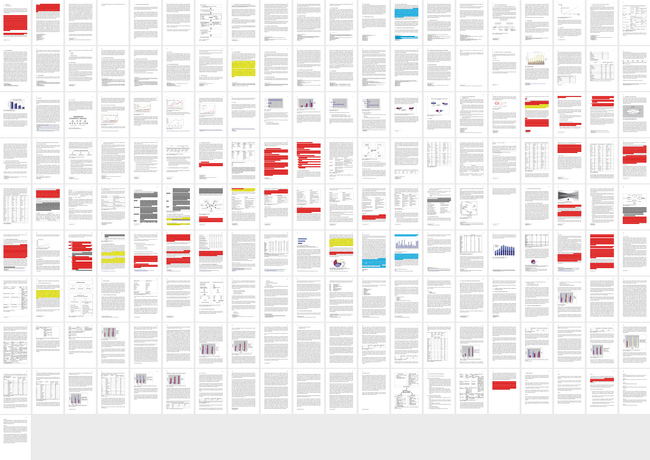Plagiarism
- Parts of the introduction on pages 1 and 2 are taken from Fernandez (2006) without referencing the source. This includes the entire literature review. In addition, the page numbers for the references in the literature review are invented. Details on this can be found here.
- Pages 78, 80, 82 and 119: Entire paragraphs are copied from an undergraduate textbook called "Global Management". The source is not mentioned anywhere in the thesis.
- Section 4.4.6. (pages 86-94) contains little what is original from the author: She either cites Fons Trompenaars, or where she does not, she tends to copy text from his books without citation (see Trompenaars (1998))
- Page 103: The author claims "Source: own compilation" for the table 5.1, but in fact, most of the content given in it stems from Wikipedia. Also the section 5.2.3. of the thesis (page 105-107) is to an unacceptable degree inspired by a Wikipedia article on the Agenda 2010.
References and bibliography
There are many footnotes with references to sources that cannot be found in the bibliography, such that it is often not clear, which text by which exact author is actually meant. The bibliography also sufferes from problems like inconsistent double and triple entries. For details on missing references and bibliography problems refer to here.

Bavarian Schoolbook
One source is worth mentioning separately: Randak (1985): Die Soziale Marktwirtschaft, Bayerische Landeszentrale für politische Bildungsarbeit, München is a Bavarian schoolbook (see picture), which makes one doubt whether it is suitable as reference in a scientific publication. Randak is cited five times in the thesis.
Not all references to Randak are correct, however: The reference found on p. 97 for a half sentence on the outcomes of the market process is given as p. 48; Randak however talks about the social marked economy as the Third Way on this page. The reference that should be to p. 98 (social market economy) is given as p. 30, but that page in Randak is dedicated to Eucken. Reference p. 99 (Eucken) is given as p. 23, but that page in Randak gives definitions of classical liberalism, socialism and keynesianism.
Scientific rigour
In the empirical part of the thesis (p. 136-176) results from interviews with 60 managers are presented and conclusions are drawn. There are several aspects of this part that make one wonder whether it complies with minimal standards of scientific rigour:
- The claim is made that quite far-reaching hypotheses are "confirmed" by the results of these interviews -- however, hardly any reference is made to the small sample size of the study and questions of statistical significance are not even asked.
- There are no details given about the selection of the interviewees
- There are no details given about the rationale according to which the questionnaire has been developed. Some questions appear to be lacking information, others are suggestive.
- There are several apparent inconsistencies in the presented results.
For more details on the empirical part, refer to here.
Other observations
Some other findings (not necessarily of plagiarism):
- p. 1 (2x): "noble prize winner" -> this is, of course, Nobel Prize Laureate
- p. 9, fn 4 : "Some anomalous evidence regarding market effiency, In Journal of Financial Economic [sic], p. 95-101." It is not clear which issue of the Journal of Finanical Economic this is. It turns out to be by Michael C. Jensen, and is entitled "Some anomalous evidence regarding market efficency" and is in Vol 6, No. 2/3, pp. 95-101, 1978. The sentence referenced, "For example the managers may purchase a company jet for prestige reasons or build a representative headquarters, although both measures may be detrimental for the company and also the shareholders." is not substantiated in this paper - there is no reference to company jets or to headquarters. Footnote 5 is " Jensen, M.C. (1978)", which is not given in the bibliography. This sentence, too, refers to a completely different topic than the paper given (bond markets).
- p. 39: The company given als "2.17" is "Merrill Lynch" in the source. A copy and paste error. It is not clear from Cs's text what the 2-5 is, in the source these are the next highest company officers after the CEO.
- p. 54: there are pie charts about the share medium sized companies have in Germany in e.g. GDP or employment. These charts come without date for which they apply and Cs gives as source for this data: "own compilation"
- p. 70: "The Swede Geert Hofstede" -> he's Dutch.
- p. 94: "45 years of Communism" -> this was taken from Trompenaars, but Trompenaars was speaking about East Germany, Cs for some reason changed this to Russia -- and now the 45 years make no sense anymore
- p 170: a surprising accumulation of typing errors: "Examples come form the DAX 30 companies e.g. von Pierre, former CEO of Sidemen’s, Scrimp, former COE of Daimler Chrysler, Ackerman, CEO of the Deutsche Bank and Pinch, former CEO of Volkswagen"
- There are numerous examples in the thesis of incorrect English, which seem hard to explain, given Cs' bilingual background and the fact that other writings of hers do not seem to suffer from this problem (see for instance material published here). The first sentence of the foreword may serve as an example: "During my international travels I have observed that the world is a very different place and that the people that live on it are also very different" (italics added)
- The English version of Question 25 of the questionnaire is different to the German version:
- German (page 201): "Glauben Sie, dass kulturspezifische Eigenschaften der Grund dafür sind, dass SOP in den angelsächsischen Ländern weiter verbreitet sind als in Deutschland?" (italics added)
- English (page 190): "Do you believe that there are cultural reasons why SOPs are more widely used in Great Britain than in Germany?" (italics added)
Statistik
- Currently there are 58 reviewed fragments documented that are considered to be violations of citation rules. For 46 of them there is no reference given to the source used („Verschleierungen“ and „Komplettplagiate“). For 7 fragments the source is given, but the extent of the used text is not made clear („Bauernopfer“).
- The publication has 181 pages that have been analyzed. On a total of 37 of these pages violations of citation rules have been documented. This represents a percentage of 20.4%. The 181 analyzed pages break down with respect to the amount of text parallels encountered as follows:
- From these statistics an extrapolation of the amount of text of the publication under investigation that has been documented as problematic can be estimated (conservatively) as about 6% of the main part of the publication.
- In all, text was taken from 21 sources.
Illustration
Folgende Grafik illustriert das Ausmaß und die Verteilung der dokumentierten Fundstellen. Die Farben bezeichnen den diagnostizierten Plagiatstyp:
(grau=Komplettplagiat, rot=Verschleierung, blau=Übersetzungsplagiat, gelb=Bauernopfer)
Die Nichtlesbarkeit des Textes ist aus urheberrechtlichen Gründen beabsichtigt.
Zum Vergrößern auf die Grafik klicken.
